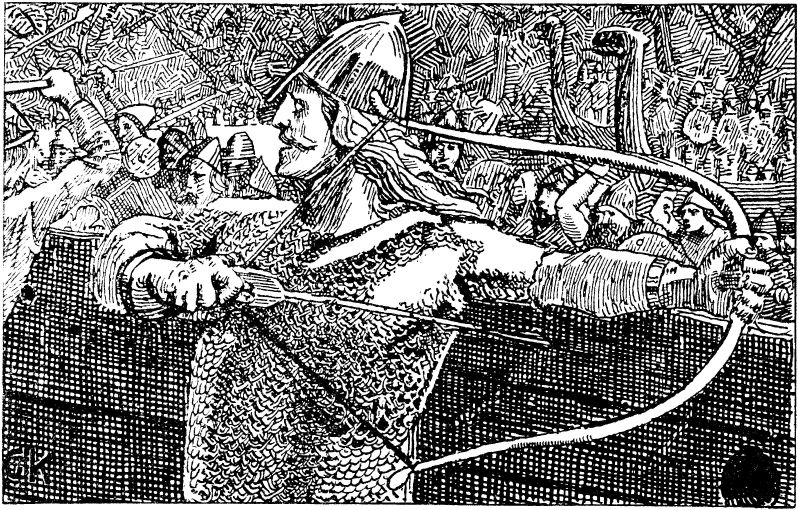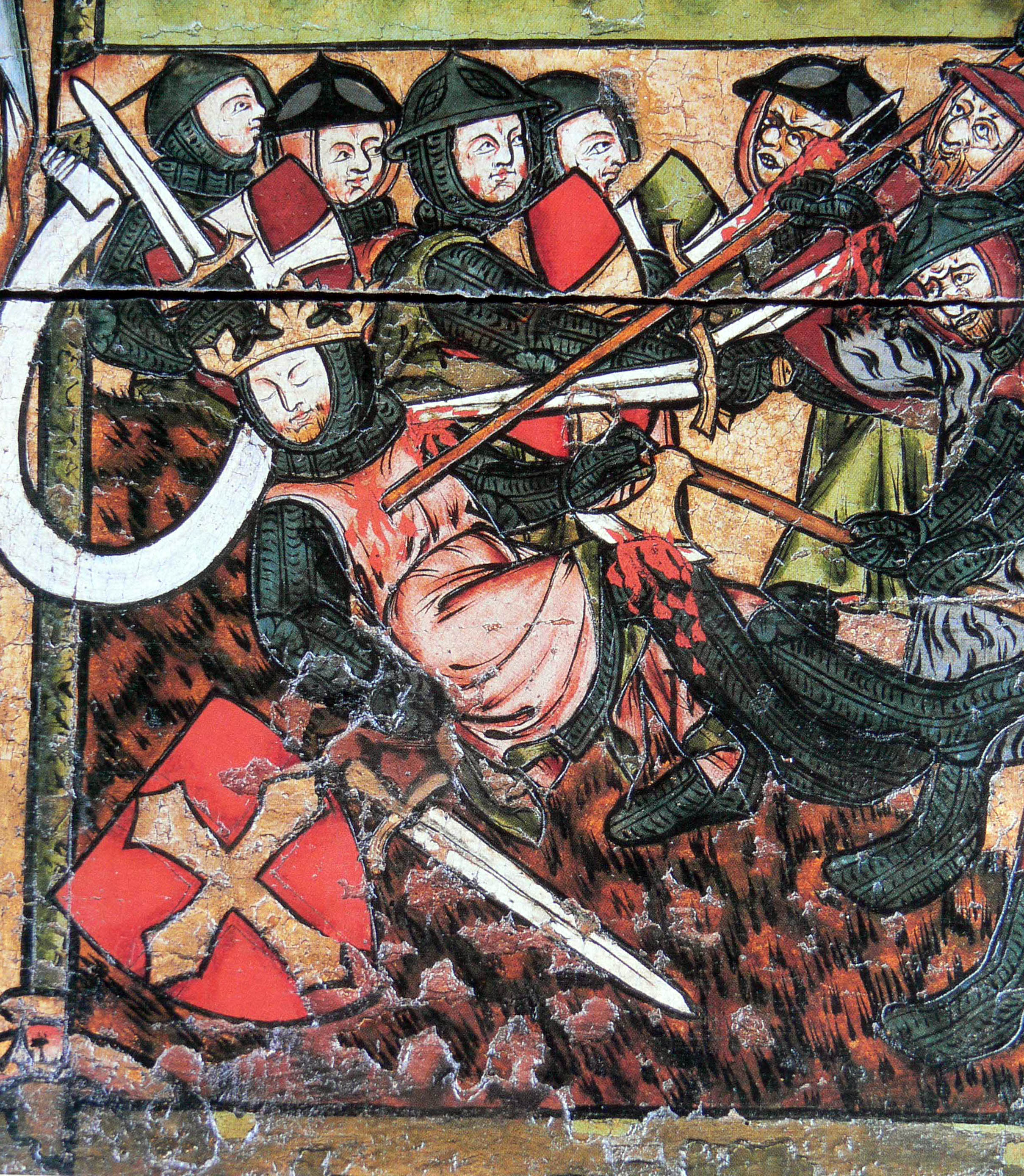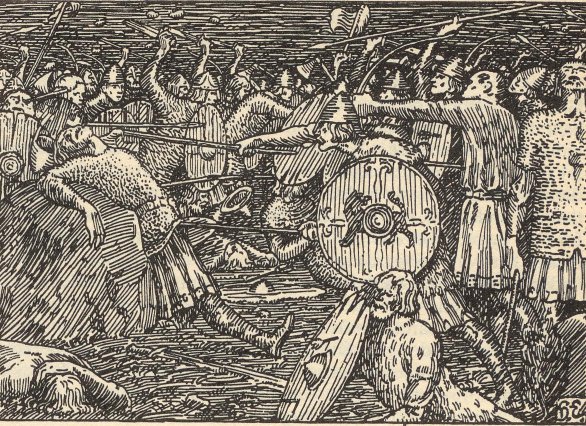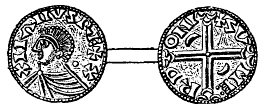|
Einar Thambarskelfir
Einar Eindridesson Thambarskelfir (c. 980–c. 1050) (Old Norse: ''Einarr Þambarskelfir'', Modern Norwegian: ''Einar Tambarskjelve'') was an influential Norwegian noble and politician during the 11th century. He headed the feudal lords in their opposition to Olaf Haraldsson. Several references are made to him in Snorri Sturluson's Heimskringla. His cognomen, ''Thambarskelfir'', has two strongly differing explanations. One is that it is derived from ', meaning "shaking bowstring". Thus, the name suggests a master of the longbow. The other is that it is derived from ', meaning "belly", and that it translates to "wobbly belly", surely an unflattering reflection of his physical build. Or it could be the “belly” of the bow. Background Einarr Thambarskelfir was the son of Eindride, a rich and influential farmer at the Viking Age political center of Melhus. Einar Thambarskelfir was a jarl and chieftain at Husaby, a farm in Skaun municipality, and a powerful warlord with his ow ... [...More Info...] [...Related Items...] OR: [Wikipedia] [Google] [Baidu] |
Olav Tryggvasons Saga - Einar Tambarskjelve - C
Olaf or Olav (, , or British ; Old Norse: ''Áleifr'', ''Ólafr'', ''Óleifr'', ''Anleifr'') is a Scandinavian and German given name. It is presumably of Proto-Norse origin, reconstructed as ''*Anu-laibaz'', from ''anu'' "ancestor, grand-father" and ''laibaz'' "heirloom, descendant". Old English forms are attested as ''Ǣlāf'', ''Anlāf''. The corresponding Old Novgorod dialect form is ''Uleb''. A later English form of the name is ''Olave''. In the Norwegian language, ''Olav'' and ''Olaf'' are equally common, but Olav is traditionally used when referring to Norwegian royalty. The Swedish form is '' Olov'' or ''Olof'', and the Danish form is ''Oluf''. It was borrowed into Old Irish and Scots with the spellings ''Amlaíb'' and ''Amhlaoibh'', giving rise to modern version '' Aulay''. The name is Latinized as ''Olaus''. Notable people North Germanic ;Denmark *Olaf I of Denmark, king 1086–1095 * Olaf II of Denmark, also Olaf IV of Norway * Oluf Haraldsen (died c. 1143), Dan ... [...More Info...] [...Related Items...] OR: [Wikipedia] [Google] [Baidu] |
Battle Of Stiklestad
The Battle of Stiklestad ( no, Slaget på Stiklestad, non, Stiklarstaðir) in 1030 is one of the most famous battles in the history of Norway. In this battle, King Olaf II of Norway () was killed. During the pontificate of Pope Alexander III, the Roman Catholic Church declared Olaf a saint in 1164. His younger half-brother, Harald Hardrada (), was also present at the battle. Harald was only fifteen when the battle of Stiklestad took place. He became King of Norway in 1047, until his death in a failed invasion of England at the Battle of Stamford Bridge in 1066. The authenticity of the battle as a historical event is subject to question. Contemporary sources say the king was murdered. According to the '' Anglo Saxon Chronicle'' of 1030, Olaf was killed by his own people. Adam of Bremen wrote in 1070 that Olaf was killed in an ambush, and so did Florence of Worcester in 1100. Those are the only contemporary sources that mention the death of the king. After the king's canoniza ... [...More Info...] [...Related Items...] OR: [Wikipedia] [Google] [Baidu] |
Harald Fairhair
Harald Fairhair no, Harald hårfagre Modern Icelandic: ( – ) was a Norwegian king. According to traditions current in Norway and Iceland in the eleventh and twelfth centuries, he reigned from 872 to 930 and was the first King of Norway. Supposedly, two of his sons, Eric Bloodaxe and Haakon the Good, succeeded Harald to become kings after his death. Much of Harald's biography is uncertain. A couple of praise poems by his court poet Þorbjörn Hornklofi survive in fragments, but the extant accounts of his life come from sagas set down in writing around three centuries after his lifetime. His life is described in several of the Kings' sagas, none of them older than the twelfth century. Their accounts of Harald and his life differ on many points, but it is clear that in the twelfth and thirteenth centuries Harald was regarded as having unified Norway into one kingdom. Since the nineteenth century, when Norway was in a personal union with Sweden, Harald has become a na ... [...More Info...] [...Related Items...] OR: [Wikipedia] [Google] [Baidu] |
Byzantine Empire
The Byzantine Empire, also referred to as the Eastern Roman Empire or Byzantium, was the continuation of the Roman Empire primarily in its eastern provinces during Late Antiquity and the Middle Ages, when its capital city was Constantinople. It survived the fragmentation and fall of the Western Roman Empire in the 5th century AD and continued to exist for an additional thousand years until the fall of Constantinople to the Ottoman Empire in 1453. During most of its existence, the empire remained the most powerful economic, cultural, and military force in Europe. The terms "Byzantine Empire" and "Eastern Roman Empire" were coined after the end of the realm; its citizens continued to refer to their empire as the Roman Empire, and to themselves as Romans—a term which Greeks continued to use for themselves into Ottoman times. Although the Roman state continued and its traditions were maintained, modern historians prefer to differentiate the Byzantine Empire from Ancient Rome ... [...More Info...] [...Related Items...] OR: [Wikipedia] [Google] [Baidu] |
Harald Sigurdsson
Harald Sigurdsson (; – 25 September 1066), also known as Harald III of Norway and given the epithet ''Hardrada'' (; modern no, Hardråde, roughly translated as "stern counsel" or "hard ruler") in the sagas, was King of Norway from 1046 to 1066. Additionally, he unsuccessfully claimed both the Danish throne until 1064 and the English throne in 1066. Before becoming king, Harald had spent around fifteen years in exile as a mercenary and military commander in Kievan Rus' and as a chief of the Varangian Guard in the Byzantine Empire. When he was fifteen years old, in 1030, Harald fought in the Battle of Stiklestad together with his half-brother Olaf Haraldsson (later Saint Olaf). Olaf sought to reclaim the Norwegian throne, which he had lost to the Danish king Cnut the Great two years prior. In the battle, Olaf and Harald were defeated by forces loyal to Cnut, and Harald was forced into exile to Kievan Rus' (the sagas' ). He thereafter spent some time in the army of Grand Pr ... [...More Info...] [...Related Items...] OR: [Wikipedia] [Google] [Baidu] |
Jerusalem
Jerusalem (; he, יְרוּשָׁלַיִם ; ar, القُدس ) (combining the Biblical and common usage Arabic names); grc, Ἱερουσαλήμ/Ἰεροσόλυμα, Hierousalḗm/Hierosóluma; hy, Երուսաղեմ, Erusałēm. is a city in Western Asia. Situated on a plateau in the Judaean Mountains between the Mediterranean Sea, Mediterranean and the Dead Sea, it is one of the List of oldest continuously inhabited cities, oldest cities in the world and is considered to be a holy city for the three major Abrahamic religions: Judaism, Christianity, and Islam. Both Israelis and Palestinians claim Jerusalem as their Capital city, capital, as Israel maintains its primary governmental institutions there and the State of Palestine ultimately foresees it as its seat of power. Because of this dispute, Status of Jerusalem, neither claim is widely recognized internationally. Throughout History of Jerusalem, its long history, Jerusalem has been destroyed at least twice, Sie ... [...More Info...] [...Related Items...] OR: [Wikipedia] [Google] [Baidu] |
Thorir Hund
Modern and imaginary presentation of Tore Hund Thorir Hund (Old Norse: Þórir hundr, Modern Norwegian: ''Tore Hund'', literally "''Thorir the Hound''") (born ca. 990) was one of the greatest chiefs in Hålogaland. Tore Hund was one of the leaders of the Stiklestad peasant faction opposing Norwegian King Olaf II of Norway, later named St. Olaf. He was reported to have been among the chieftains who killed the king in the Battle of Stiklestad in 1030. He also served in the forces of King Canute the Great on several occasions."Tore Hund" '''' Background Thorir Hund was born at the beginning of the[...More Info...] [...Related Items...] OR: [Wikipedia] [Google] [Baidu] |
Harthacnut
Harthacnut ( da, Hardeknud; "Tough-knot"; – 8 June 1042), traditionally Hardicanute, sometimes referred to as Canute III, was King of Denmark from 1035 to 1042 and King of the English from 1040 to 1042. Harthacnut was the son of King Cnut the Great (who ruled Denmark, Norway, and England) and Emma of Normandy. When Cnut died in 1035, Harthacnut struggled to retain his father's possessions. Magnus I took control of Norway, but Harthacnut succeeded as King of Denmark and became King of England in 1040 after the death of his half-brother Harold Harefoot, king of England. Harthacnut himself died suddenly in 1042 and was succeeded by Magnus in Denmark and Edward the Confessor in England. Harthacnut was the last Dane to rule England. Early life Harthacnut was born shortly after the marriage of his parents in July or August 1017. Cnut had put aside his first wife Ælfgifu of Northampton to marry Emma, and according to the '' Encomium Emmae Reginae'', a book she inspired many ... [...More Info...] [...Related Items...] OR: [Wikipedia] [Google] [Baidu] |
Magnus I Of Norway
Magnus Olafsson (Old Norse: ''Magnús Óláfsson''; Norwegian and Danish: ''Magnus Olavsson''; – 25 October 1047), better known as Magnus the Good (Old Norse: ''Magnús góði'', Norwegian and Danish: ''Magnus den gode''), was King of Norway from 1035 and King of Denmark from 1042 until his death in 1047. Magnus was an illegitimate son of King Olaf II of Norway, and fled with his mother Alfhild when his father was dethroned in 1028. He returned to Norway in 1035 and was crowned king at the age of 11. In 1042, he was also crowned king of Denmark. Magnus ruled the two countries until 1047, when he died under unclear circumstances. After his death, his kingdom was split between Harald Hardrada in Norway and Sweyn Estridsson in Denmark. Early life Magnus was an illegitimate son of King Olaf Haraldsson (later St. Olaf), by his English concubine Alfhild,Carl Frederik Bricka, ''Dansk Biografisk Lexikon'', vol. XI aar – Müllner 1897p.44 originally a slave (thrall) of Olaf's q ... [...More Info...] [...Related Items...] OR: [Wikipedia] [Google] [Baidu] |
Garðaríki
(anglicized Gardariki or Gardarike) or is the Old Norse term used in medieval times for the states of Kievan Rus. As the Varangians dealt mainly with Northern Kievan Rus' lands, their sagas regard the city of (, Veliky Novgorod) as the capital of . Other local towns mentioned in the sagas are (Old Ladoga), (Polotsk), (Smolensk), (Suzdal), (Murom), and (Rostov). Three of the Varangian runestones, G 114, Sö 338, and U 209, refer to Scandinavian men who had been in . Etymology The word , which first appeared in Icelandic sagas in the twelfth century, could stem from the words and according to the common Scandinavian pattern for state formations ''X+ríki'', therefore this term could be translated into English as "the kingdom of Garðar". The name itself was used in skaldic poems, runic inscriptions and early sagas up to the twelfth century to refer to the lands to the east of Scandinavia populated by the Rus' people. is a plural form of the Old Norse word whi ... [...More Info...] [...Related Items...] OR: [Wikipedia] [Google] [Baidu] |
Ælfgifu Of Northampton
Ælfgifu of Northampton ( non, Álfífa, 990 – after 1036) was the first wife of Cnut the Great, King of England and Denmark, and mother of Harold Harefoot, King of England. She was regent of Norway from 1030 to 1035. Biography Family background Ælfgifu was born into an important noble family based in the Midlands (Mercia). She was a daughter of Ælfhelm, ealdorman of southern Northumbria, and his wife Wulfrun. Ælfhelm was killed in 1006, probably at the command of King Æthelred the Unready, and Ælfgifu's brothers, Ufegeat and Wulfheah, were blinded. Wulfric Spot, a wealthy nobleman and patron of Burton Abbey, was the brother of Ælfhelm or Wulfrune. The family again came under suspicion during the invasion of England by Swein Forkbeard, King of Denmark, in 1013–14, and further members were charged with treachery and killed. It is possible that Ælfgifu was a kinswoman of the wife of Ælfgar, Earl of Mercia, also called Ælfgifu. Marriage to Cnut When Swein invad ... [...More Info...] [...Related Items...] OR: [Wikipedia] [Google] [Baidu] |







